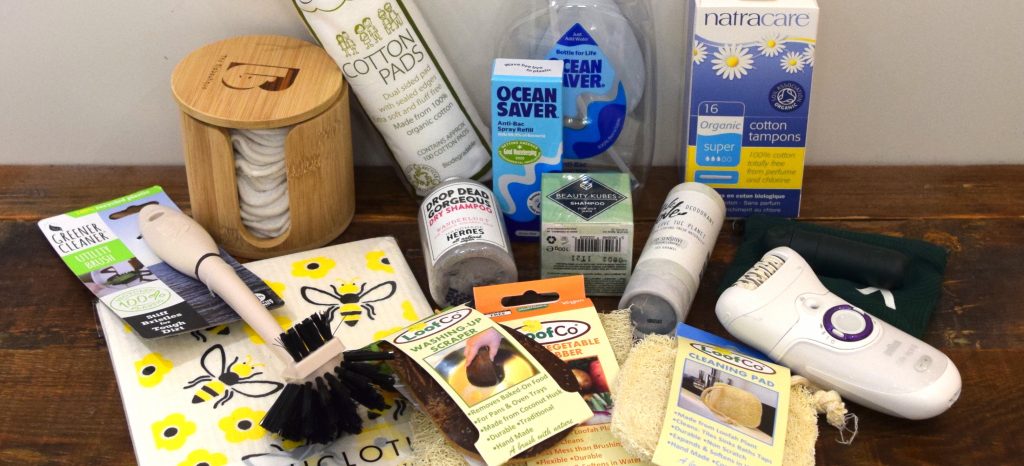
I’ve been doing an audit of my life as a consumer and seeing where I can make some more ethical and environmentally sustainable choices. Turns out there were at least 12 easy swaps I could make around the home!
Here in the UK, we’re committed to achieving net-zero carbon emissions by 2050 under the Paris Agreement with the ultimate goal of avoiding dangerous climate change. According to the Commission on Climate Change (the UK’s independent body advising on carbon reductions), approximately 40% of UK emissions come from “households” (i.e. the actions of individuals). This includes our heating, electricity, waste, transport, and air travel. While of course, it’s essential that the government enact policies and businesses take action to target the other 60%, there are certainly ways in which we can change our behaviour and do our bit.
For those who want to contribute through positive individual change, it can be difficult to know where to start! For me, I found it easiest to begin by thinking about different areas of my life and where the most impact might be. I don’t drive or have a car, but I do travel and take flights (I’ll cover this in a separate article coming soon!), and, particularly in 2020, I generate packaging waste and use domestic electricity and gas for heating. An initial focus for me was clearly within my home.
I then went on an “audit” of my home, going from room to room, thinking where I currently use the most energy, generate waste through products with plastic packaging, and also going beyond carbon generation to think about other damaging environmental impacts like products containing water-polluting chemicals etc. Next, I did some research into what possible alternatives might make a difference, and then finally, decided where I personally was comfortable making changes and substitutions.
Here are some of the initial swaps I’ve been able to make with a goal of having a more sustainable home- maybe some could work for you too!
Home energy
Let’s start with a biggie: of the total carbon footprint of the average home, roughly 29% of this comes from heating and 21% from electricity (source: CCC). There are substantial changes homeowners can make like investing in improved roof insulation, installing solar panels, and replacing an inefficient boiler. For me, living in a flat with little control over these factors (and a brand new boiler), I had to look elsewhere to make a change.
I decided that an easy switch I could make was to purchase 100% renewable home energy. While this is relatively easy to find to cover electricity, sourcing renewable gas is not so common- we don’t produce enough biogas in the UK to cover demand, so most “renewable” energy tariffs just refer to the electricity portion only.
There are, however, some providers offering “green gas” or “carbon neutral” tariffs that go that one step further. Usually, these tariffs involve the consumer paying a little extra for the tariff and in exchange, the provider will offset the carbon generated by the gas. Some are even more sophisticated and will also offset the emissions generated in the production (the building of a wind farm for example) and distribution of the energy (yes, this creates emissions too!).
Purchasing greener home energy doesn’t mean you’ll be getting ripped off either. If you like using the very popular comparison websites for your energy, this can still be done, just filter on “renewable tariffs only”, and you can compare prices amongst the sub-set and get a “good deal”, both for your wallet and the environment!
So, to kick off:
Swap 1: I switched from a fossil fuel to a renewable and carbon neutral home energy tariff
The Bathroom
Next on my domestic audit, I stepped inside my home and began to think room-by-room. Starting off in my bathroom, a peek inside my cabinet and draws revealed a swathe of plastic packaging containing my various lotions and potions.
To think through where I could make changes, I asked myself some questions following sustainability principles: for example, could a liquid product (usually in plastic packaging) be replaced by a solid product? Following this idea, I was able to swap out my shampoo for little solid shampoo cubes, my foam face wash with a solid soap, and my body wash for a bar of soap. These have taken a bit of getting used to, but I can say I’m converted now as solid products have certainly developed and aren’t as skin-stripping as they used to be!
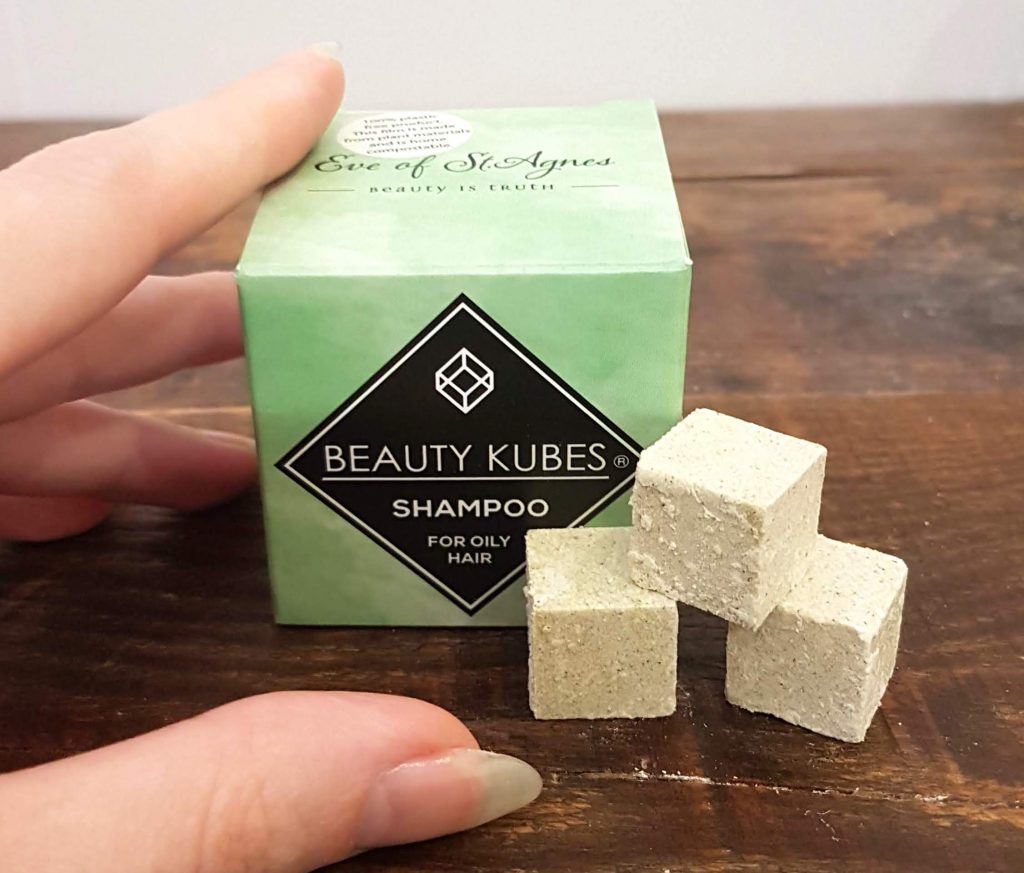
Ingenious shampoo cubes!
Secondly, can a disposable product be substituted with something that can be reused? This made me think through my use of cotton pads that I use for cleanser and makeup removal, and I discovered reusable pads made from sustainable bamboo that can be washed out and reused – brilliant! Along similar lines, I prefer applicator tampons (I’ve tried a moon cup, but no joy I’m afraid) and discovered a nifty reusable tampon applicator tool, DAME, that can be used with any non-applicator tampon (I’ve switched to organic cotton here to minimise the chemical impact of processing cotton).
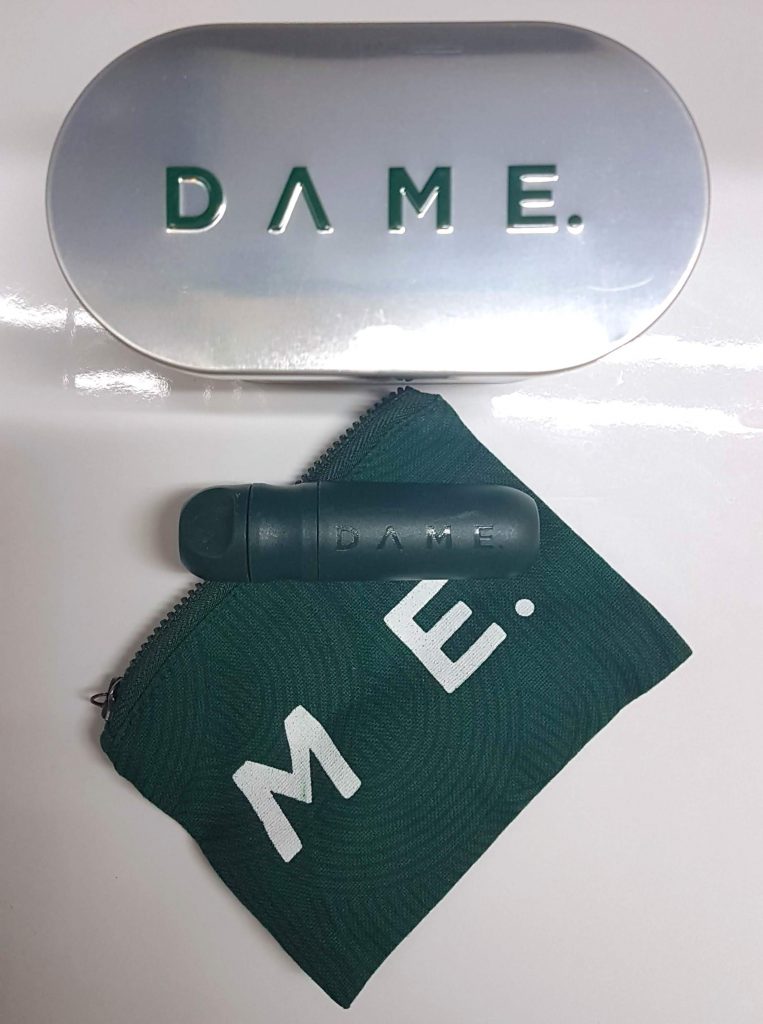
DAME reusable applicator- handy tampon tin and travel bag included!
Next, I considered whether I could source any products in more eco-friendly packaging? My instant thought here were the cans of dry shampoo aerosol I seem to race through. I discovered a power product in a small recyclable bottle does the trick just as well and lasts for absolutely ages. Another great win here was substituting my usual deodorant encased in plastic, with a natural deodorant product in a cardboard tube. Not only is this better for my skin health, containing no aluminium or unnecessary chemicals, it has a much lower packaging footprint and I’m able to support a small business all at the same time- fresh and ethical armpits!
Finally, if there were any liquid products that I couldn’t do without, I sought to find out: does the product come in large volumes? I was able to do this with my preferred hair conditioner: I found 1 litre bottles on the internet that are used to supply hairdressers and come with a very handy pump. One has lasted me a whole year!
To summarise, the swaps I made in the bathroom were:
Swap 2: change from liquid products to solid bars for shampoo, face wash, and body wash
Swap 3: standard deodorant in plastic packaging to a natural deodorant in cardboard eco-packaging
Swap 4: cotton cosmetic pads for bamboo pads or organic cotton pads (for the few remaining products that I have that aren’t suited to the bamboo)
Swap 5: dry shampoo aerosol to a dry shampoo powder in small recyclable bottle
Swap 6: standard applicator tampons to a DAME reusable applicator
The Kitchen
My next stop was the kitchen where food and cleaning products were the key areas for me to think through. According to the Waste and Resources Action Programme (WRAP), UK homes throw away 4.5m tonnes of food a year which could have been eaten. To try to reduce my own food waste, I try to plan my meals and shop for specific ingredients to avoid those “what do I do with this?!” moments after getting over enthusiastic at the supermarket! (I still don’t know what to do with okra!)
In 2020, when food shopping during lockdown has been a risky activity, I’ve also sought out food delivery services. My favourite is my weekly organic veg box (I get mine from Able & Cole), which not only encourages me to eat more veg and meat-free meals, but also supports organic farming across the UK. There is minimal packaging as the boxes are collected and reused each week, inner boxes and bags are compostable, and even delivery is “green” in electric vehicles.
Moving seamlessly on from veg boxes to scrubbing and preparing this veg, I discovered there are alternatives to the plastic cleaning tools sitting beside my sink. I found alternative cleaning pads and a root vegetable scrubber made from loofah! The naturally coarse material makes these excellent at scrubbing potatoes (even if using it does give me flashbacks to having a bath!). I also discovered a recycled and recyclable washing up scrubbing brush, a pan scourer made from coconut shell (instead of the green wire wool pads I usually go for), and even attractive reusable dishcloths made from compostable materials.
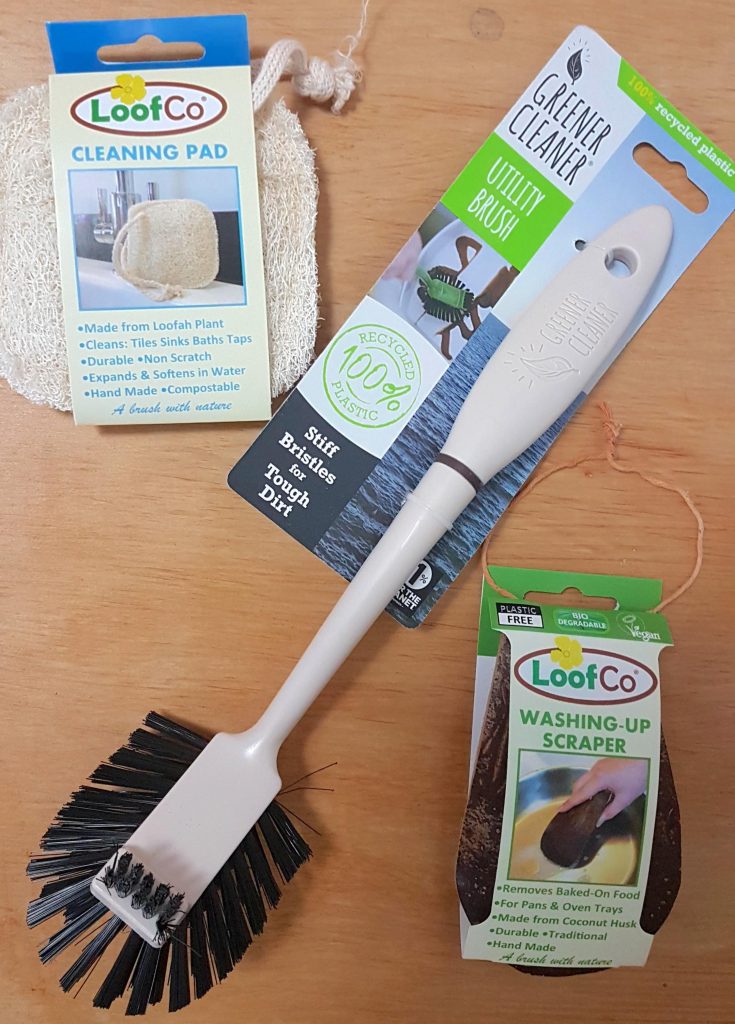
Eco cleaning tools!
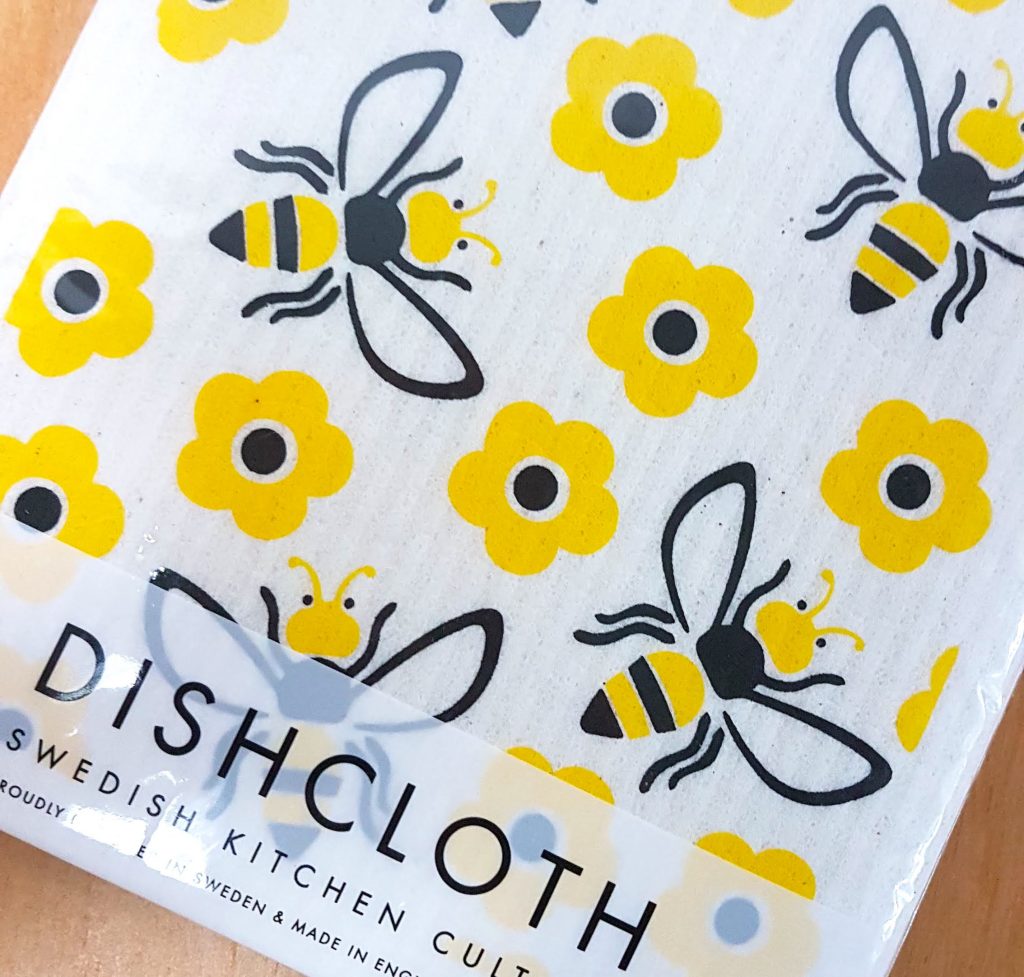
Reusable, compostable, and adorable dishcloths!
Finally, cleaning products can contain chemicals that are damaging to the environment and generate water pollution, as well as being supplied in single-use plastic bottles. I switched out my usual antibacterial surface cleaner for one in a refill bottle which promises to use more gentle active ingredients and use less packaging. This comes with an empty spray bottle and a container of concentrated cleaning fluid that you add and dilute with water to fill the bottle. This can be reused and the refill capsules are super small, thus reducing the packaging impact for a very long time!
My swaps in the kitchen were:
Swap 7: randomly shopping on a whim to planning meals to avoid food waste
Swap 8: my usual diet to one based around organic veg!
Swap 9: plastic cleaning tools for eco-materials: cleaning pads and root vegetable scrubber made from loofah, coconut shell scourer, recycled washing up brush, reusable and compostable dishcloths
Swap 10: chemical cleaning products in single-use plastic to refillable cleaning products
The Bedroom
Moving on to the bedroom, the space which, for me, is dominated by several wardrobes housing my beloved clothes. It has been calculated that the fashion industry accounts for 10% of global greenhouse gas emissions– quite a shocking statistic! I’ve written previously about my love of vintage and thrift shopping for the style and environmental benefits, plus shared some of my tips for anyone who might be new to this or intimidated by how to start. I’d encourage anyone to give this a go to help put an end to “fast fashion” and the hugely negative impact this has!

Vintage and second hand clothes are SO much fun!!
Buying more second hand rather than new clothing can be a really impactful individual sustainability win, so while not so new for me, it’s going in here:
Swap 11: new clothing from “fast fashion” brands replaced by second-hand or thrifted clothing
The Office
The final room to cover was my home office space, somewhere I’ve spent a lot of time in 2020! The most immediate impact here, aside from electricity use for my laptop, was the use of paper. To reduce paper usage, I have tried to keep as many notes as possible in digital format online (saved safely on a cloud), which also has the benefit of avoiding my often illegible handwriting.
For when hand-written notes are essential, I have created little “notebooks” using old pieces of paper stapled together – I learned this from my parents who are still using the blank sides of draft pages from my PhD thesis to write their shopping lists! I also use old envelopes from the odd bill that I haven’t been able to switch to online billing for, and packing slips from deliveries – get creative!
Swap 12: notebooks from “virgin” paper to online notes or blank sides of scrap paper
This is just a small start in greening-up my life and I still have a long way I want to go! Next on my list to investigate are alternatives to dental floss, move away from reliance on disposable ballpoint pens, and look into carbon neutral broadband. Are there any eco-swaps you’ve made? Please get in touch in the comments below, on Insta, or via DM- I’d love to hear more inspiration!
Thanks for reading 